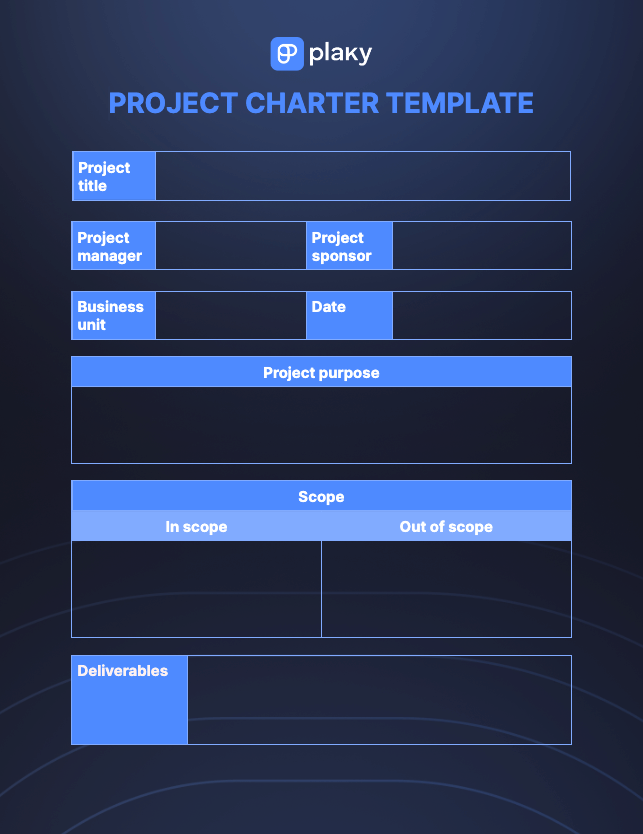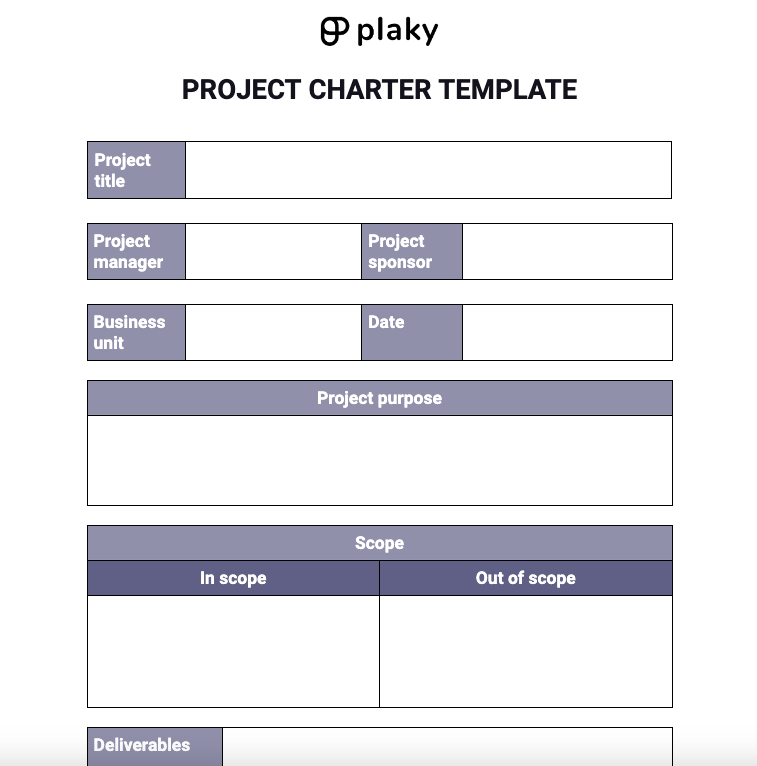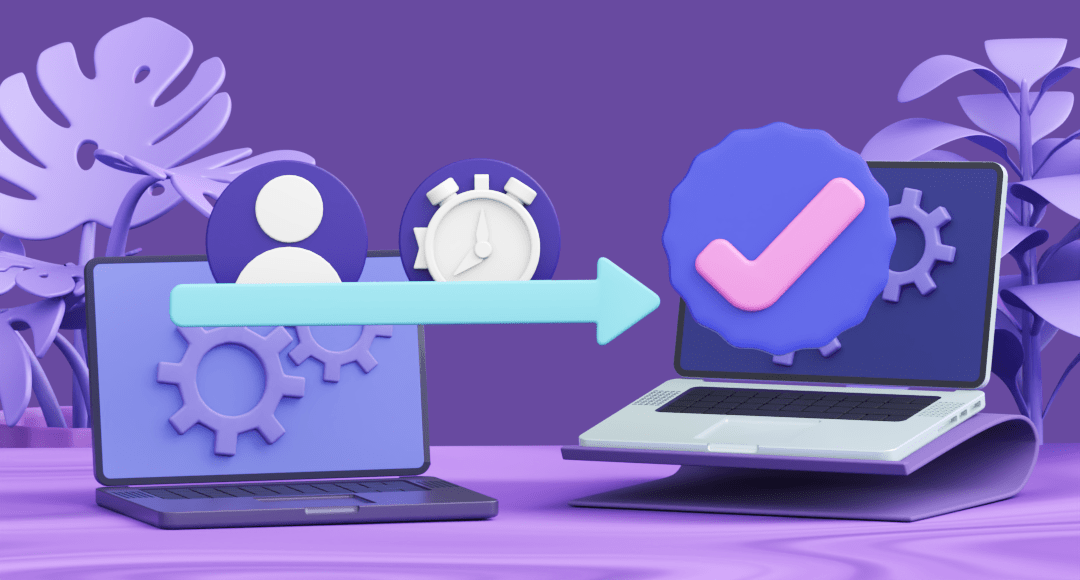What Is a Project Charter? Example + Free Template Included
Suppose you have a great business idea for your department’s next project. But, having an idea is not sufficient to bring your project to life. You must present it to the right people and get their approval.
For this purpose, you’ll need a project charter.
In this guide, we’ll cover the project charter definition and its key elements.
Also, we’ll explain the main differences between a project charter and other vital project management documents.
To make the concept clearer, we’ve prepared a project charter example followed by a free project charter template.
Let’s dive into the matter.

- A project charter is a project management document that formally acknowledges the existence of a project and serves as an elevator pitch for the project.
- The main purpose of a project charter is to secure approvals for project execution from the stakeholders.
- There is no universal list of project charter elements, but a good project charter should ideally include 12 elements, some of which include project purpose, scope, deliverables, resources, milestones, risks, and others.
- The easiest way to create a project charter for stakeholders is to discuss all specifics with your team first and then briefly cover important project information in a premade template.
Table of Contents
What is a project charter?
A project charter is a project management document that formally acknowledges the existence of a project and serves as an elevator pitch for the project, aiming to secure approvals for its execution.
In essence, a project charter is a high-level overview of your project. It should include a brief explanation of the main elements of your project as this enables project stakeholders to understand your project scope, objectives, and responsibilities.
Project sponsors or the person who initiated the project are usually the ones in charge of this document.
When approved, the project charter gives a project manager the authority to apply organizational resources to project activities.
What are the 12 components of a project charter?
There is no universal list of project charter elements, but a good project charter should ideally include the following 12 elements:
- Project title,
- General project information,
- Project purpose,
- Scope,
- Deliverables,
- Resources,
- Milestones,
- Risks,
- Project team structure,
- Key stakeholders,
- Success measurements, and
- Project approval.
Let’s briefly explain each of these elements.
Component #1: Project title
Your project name should always be straightforward and descriptive.
For instance, if you intend to create additional landing pages for products on the website you are developing, the name can be “Developing new product landing pages — website X.”
Component #2: General project information
The general information that every project charter should include is the following:
- The project manager,
- The project sponsor,
- The business unit responsible for the project execution, and
- The date when the project was pitched.
Component #3: Project purpose
Your project should have justified reasons for being conducted.
To identify the project purpose, try answering the following questions:
- What business needs will this particular project meet?
- What do you want to achieve with your project?
- How do your goals and objectives align with larger organizational goals?
Also, it’s advised to use the SMART criteria for setting your project goals and objectives more easily.
Component #4: Scope
Briefly summarizing what will and will not be included in the project tasks ensures that you stay on the same page with your client and prevent misunderstandings.
Component #5: Deliverables
Depending on your project type, deliverables can be various products or services you get upon the completion of a project. Here are some common examples of key deliverables:
- Business cases,
- Landing pages for different products,
- Prototypes,
- Wireframes, etc.
Defining deliverables provides a clear end goal for your project, which makes your project charter much more valuable to stakeholders — and more likely to get approved.
Component #6: Project resources
Make sure you have an estimated project budget to begin with. In addition to the financial considerations, you should also identify:
- The number of people you’ll need for the project,
- The necessary equipment, and
- Other project resources, depending on the industry, project type, and complexity.
💡 Plaky Pro Tip
Identifying and organizing your project resources is much easier with a ready-made template. Check out our free resource planning templates below:
Component #7: Project milestones
Apart from predicting anticipated start and end dates, it’s advised to identify all key project milestones and when they will be completed.
Component #8: Risks
Providing a list of potential project risks and explaining how they can affect the outcome of your project in the early stages can help mitigate more significant issues later in the project.
So, take your time to ponder potential project risks and write down what could go wrong.
💡Plaky Pro Tip
Read this guide to learn how to implement risk management practices into your projects:
Component #9: Project team structure
Make a list of people who will participate in the project and specify their project roles and responsibilities.
To better define the team structure, try answering the following questions:
- Who will be responsible for managing the project?
- Who are the other people who will be working on the project?
- What are their responsibilities?
Component #10: Key stakeholders
It is vital to name the main project stakeholders, both those within or outside the organization, as they can have an influence on the project’s outcome.
In your project charter, you should mention who’s in charge of:
- Funding,
- Project charter approval, and
- Other key responsibilities.
Component #11: Success measurements
Identify the metrics you will be using and the targets you want to achieve with your project.
Take the budget key performance indicator for an example – you can mark the project as successful if you achieve overall cost savings of $100,000 or reduce production time by 25%.
Component #12: Project approval
In the end, specify who signs off on the project, that is, who is in charge of approving the project charter.
Project charter example
Now that we’ve explained all the elements of a project charter, it is time to see the project charter in action.
To illustrate the matter, we will provide an example of a project related to mobile application development with all the relevant parts of the project included.
Suppose you want to develop a food ordering app.
Then, your sample project charter can look like the following example.
| Element | Description |
|---|---|
| Project title | Go Guacamole food ordering app |
| General project information | Project manager: Marry Stark Project sponsor: James Jones Business unit: Product development Date: 03.03.2024. |
| Project purpose | – Food ordering app for vegans and vegetarians. – The app will be available on Google Play and App Store. – The aim is to simplify vegetarian and vegan food ordering from our physical Go Guacamole stores. – The app enables ordering via a mobile phone and delivery in major US cities. |
| Scope | In scope: – Operating system: iOS, Android, – UI and UX design, – Image optimization, – Cloud backup, – Basic analytics, – Load testing, and – Basic design modifications. Out of scope: – Adding new plugins or functionalities, – Managing product inventory, and – Marketing automation. |
| Project milestones | Start date: April 4, 2024 Design proposals finished: May 4, 2024 App development completed: July 7, 2024 QA testing ended: August 15, 2024 Product descriptions completed: August 26, 2024 Launching date: September 1, 2024 |
| Goals and objectives | – Increasing sales by 20% in the first quarter after launching – Establishing our company as a leader in the vegetarian and vegan food space in the US |
| Deliverables | – Style guide, – Wireframes, – User Interface, – Compiled versions of the app, – Private keys and certificates, – Credentials, – Other development specifications, and – Bug and issue documentation. |
| Risks | The team may not meet deadlines due to: – Adding unplanned changes in the specification or expanding requirements with more features. |
| Resources | People: 11 people working on a project – 3 developers, – 1 project manager, – 1 business analyst, – 1 finance manager, – 2 designers, – 1 product manager, and – 2 QA software testers Time: 5 months for project completion Budget: $100,000 |
| Key stakeholders | CEO: Peter Drake Project sponsor: James Jones Project investor: Mark Johansson |
| Project team structure | Project manager: Marry Stark Product manager: Emily Boyle Business analyst: Terry Knope Finance manager: Piter Blunt Designers: Mark Wild, Lucy Dale QA team: Tamara Jonas, Natasha PotterDevelopers: Philip Levison, Simon Nowicki, Maria Barres |
| Success measurements | – The app has at least 5,000 downloads on Google Play and App Store in the first month. – The app has 4–5 stars on Google Play and App Store and more than 15 positive reviews on each platform in the first 2 months after launching. |
| Project approval | CEO: Peter DrakeInvestor: Mark Johansson Sponsor: James Jones Project manager: Marry Stark Finance manager: Piter Blunt Date of approval: 04.03.2024. |
Project charter template
Remember — no one enjoys reading a wall of text.
So, apart from making sure your project charter is not overly long, ensure you make it visually appealing to people who must read it and decide on its approval — you can achieve this via proper structuring and formatting.
Separate the sections of your charter using tables, to make your document easier to scan and digest.
We suggest using a simple project charter template.
Don’t worry — you don’t have to lose your precious time creating such a template.
We have prepared an easy-to-use project charter template you can edit and download for free.

🔽 Download the project charter template
If you prefer to print and fill out the project charter template manually, we’ve also prepared a print-friendly version.

🔽 Download the project charter template for printing
What is the difference between a project plan and a project charter?
The main difference between a project plan and a project charter is that the project charter is created before a project plan, and its purpose is to secure project approval and give the project manager authority to start working on the project.
Unlike the project charter, which describes the entire project on a macro level, the project plan goes into the essence of all the project phases.
The project plan provides a more in-depth outline of the project’s key elements and explains how project activities will be executed.
What is the difference between a project brief and a project charter?
The main difference between a project brief and a project charter is that a project brief provides a short description of the key elements of your project plan, while a project charter aims to authorize the project formally.
In other words, the project brief is the summary of the project plan and is created after obtaining the project’s approval. It serves as the reference point for your project team and stakeholders.
What is the difference between a business case and a project charter?
The main difference between a business case and a project charter is that the business case explains why the company should spend its resources on a specific project, detailing the benefits and risks of a significant business investment. In addition, the business case involves making project assumptions in terms of costs and expected revenue to determine its financial justification.
In contrast, the project charter outlines, at a macro level, what needs to be done and establishes project constraints such as budget, project timeline, and scope.
Both of these documents are created during the project initiation phase, but the two terms are not interchangeable.
How to create a project charter
There is no universally accepted procedure on how to build a project charter. But, we have selected some tips that can come in handy:
- Discuss the charter with your project team,
- Keep it short and simple,
- Include all vital information, and
- Present the project charter to relevant parties and secure approval.
Let’s explain each step.
Step #1: Discuss the project charter with your team
No one expects the project manager to be Superman. A team is always stronger than just one person, as everyone brings their experience and specific knowledge to the table.
So, join your forces and ask each team member for their opinion about the project.
Discuss project goals, milestones, and risks with your team.
Insights from your team members can help you catch crucial details and create a more accurate project charter.
After all, the more precise the benefits of a project charter are, the better the chances are that stakeholders will approve it.
Step #2: Keep your project charter short and simple
A project charter should be on point — clear and concise. You want to sell your project and not annoy key stakeholders with unnecessary details that may contribute to them giving up on your project.
Sure, with other planning documents, such as a project plan, feel free to go into more detail. But, each project charter section should only be 1 or 2 sentences long.
Step #3: Include all vital information in your project charter
Although there is no universal list of elements we can apply to all project charters, certain information should not be omitted, including the following:
- Objectives of a particular project,
- Known risks and project constraints, and
- Stakeholders and team members.
Step #4: Present your project charter to relevant parties and secure approval
If you want your project to get approval, you should do more than just email your project charter to key stakeholders as a PDF.
Instead, you could organize a presentation or book a meeting to explain what you intended to achieve with a particular project.
Also, this is an excellent opportunity to answer the stakeholders’ questions and ease their concerns, if any.
What is the purpose of a project charter?
There are several reasons why you need a project charter. Some of the most common purposes of a project charter include the following:
- The project charter serves as the project’s marketing tool to secure stakeholders’ approval — it’s a brief description of your project, and it “sells” your project to key stakeholders in charge of the project approval.
- The project charter authorizes the existence of a project — without getting approval from stakeholders — there is no project. The primary purpose of a project charter is to authorize the existence of your project. After project charter approval, a project manager can begin initiating and executing the project.
- The project charter explains the business importance of the project — before carrying out a project, you need to make sure that stakeholders understand the business importance of the project and where they are investing their resources.
- The project charter helps prevent scope creep — it outlines the project’s parameters so that everyone can understand them.
Make sure your project meets its goals with Plaky
Getting a project off the ground can be an achievement in itself, but seeing it through to completion is the real challenge. To keep your project on track, you should use a comprehensive project management tool such as Plaky.
With Plaky, you can:
- Create project boards for each project,
- Create tasks and group them as needed,
- Track a variety of important information related to each task,
- Communicate with team members via task-specific threads,
- Share files with no limit on maximum storage space,
- Choose between Table, Kanban, and Gantt view modes, and much more.
If you’re unsure whether Plaky is the right choice for you, there’s a 14-day free trial that gives you full access to the app’s feature set.
After that, you can continue using the Free plan indefinitely, opt for one of the premium plans, or go with the full CAKE.com software bundle.
 Project Management Hub
Project Management Hub 











